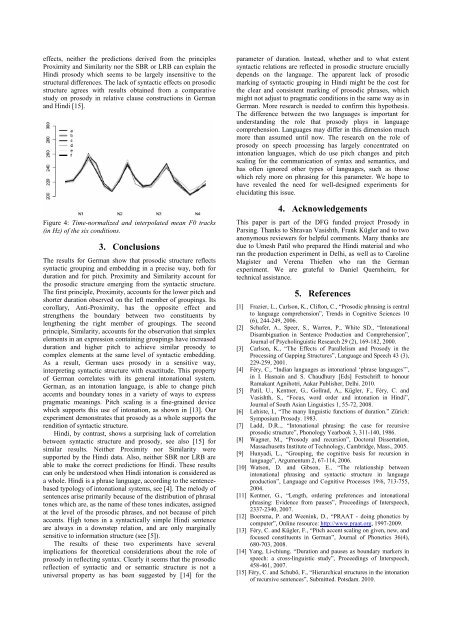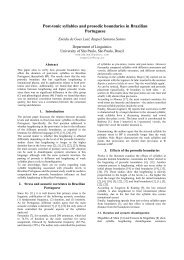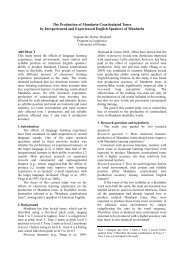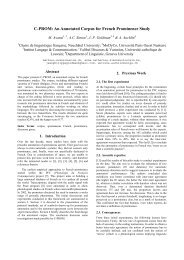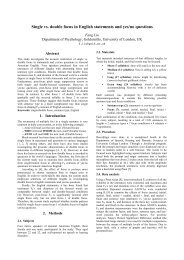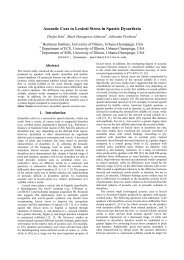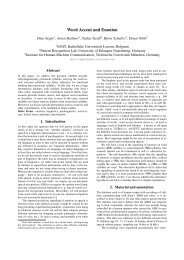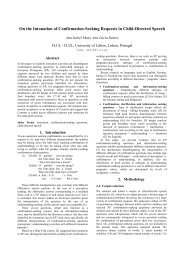The prosody of embedded coordinations in German and Hindi
The prosody of embedded coordinations in German and Hindi
The prosody of embedded coordinations in German and Hindi
Create successful ePaper yourself
Turn your PDF publications into a flip-book with our unique Google optimized e-Paper software.
effects, neither the predictions derived from the pr<strong>in</strong>ciples<br />
Proximity <strong>and</strong> Similarity nor the SBR or LRB can expla<strong>in</strong> the<br />
H<strong>in</strong>di <strong>prosody</strong> which seems to be largely <strong>in</strong>sensitive to the<br />
structural differences. <strong>The</strong> lack <strong>of</strong> syntactic effects on prosodic<br />
structure agrees with results obta<strong>in</strong>ed from a comparative<br />
study on <strong>prosody</strong> <strong>in</strong> relative clause constructions <strong>in</strong> <strong>German</strong><br />
<strong>and</strong> H<strong>in</strong>di [15].<br />
Figure 4: Time-normalized <strong>and</strong> <strong>in</strong>terpolated mean F0 tracks<br />
(<strong>in</strong> Hz) <strong>of</strong> the six conditions.<br />
3. Conclusions<br />
<strong>The</strong> results for <strong>German</strong> show that prosodic structure reflects<br />
syntactic group<strong>in</strong>g <strong>and</strong> embedd<strong>in</strong>g <strong>in</strong> a precise way, both for<br />
duration <strong>and</strong> for pitch. Proximity <strong>and</strong> Similarity account for<br />
the prosodic structure emerg<strong>in</strong>g from the syntactic structure.<br />
<strong>The</strong> first pr<strong>in</strong>ciple, Proximity, accounts for the lower pitch <strong>and</strong><br />
shorter duration observed on the left member <strong>of</strong> group<strong>in</strong>gs. Its<br />
corollary, Anti-Proximity, has the opposite effect <strong>and</strong><br />
strengthens the boundary between two constituents by<br />
lengthen<strong>in</strong>g the right member <strong>of</strong> group<strong>in</strong>gs. <strong>The</strong> second<br />
pr<strong>in</strong>ciple, Similarity, accounts for the observation that simplex<br />
elements <strong>in</strong> an expression conta<strong>in</strong><strong>in</strong>g group<strong>in</strong>gs have <strong>in</strong>creased<br />
duration <strong>and</strong> higher pitch to achieve similar <strong>prosody</strong> to<br />
complex elements at the same level <strong>of</strong> syntactic embedd<strong>in</strong>g.<br />
As a result, <strong>German</strong> uses <strong>prosody</strong> <strong>in</strong> a sensitive way,<br />
<strong>in</strong>terpret<strong>in</strong>g syntactic structure with exactitude. This property<br />
<strong>of</strong> <strong>German</strong> correlates with its general <strong>in</strong>tonational system.<br />
<strong>German</strong>, as an <strong>in</strong>tonation language, is able to change pitch<br />
accents <strong>and</strong> boundary tones <strong>in</strong> a variety <strong>of</strong> ways to express<br />
pragmatic mean<strong>in</strong>gs. Pitch scal<strong>in</strong>g is a f<strong>in</strong>e-gra<strong>in</strong>ed device<br />
which supports this use <strong>of</strong> <strong>in</strong>tonation, as shown <strong>in</strong> [13]. Our<br />
experiment demonstrates that <strong>prosody</strong> as a whole supports the<br />
rendition <strong>of</strong> syntactic structure.<br />
H<strong>in</strong>di, by contrast, shows a surpris<strong>in</strong>g lack <strong>of</strong> correlation<br />
between syntactic structure <strong>and</strong> <strong>prosody</strong>, see also [15] for<br />
similar results. Neither Proximity nor Similarity were<br />
supported by the H<strong>in</strong>di data. Also, neither SBR nor LRB are<br />
able to make the correct predictions for H<strong>in</strong>di. <strong>The</strong>se results<br />
can only be understood when H<strong>in</strong>di <strong>in</strong>tonation is considered as<br />
a whole. H<strong>in</strong>di is a phrase language, accord<strong>in</strong>g to the sentencebased<br />
typology <strong>of</strong> <strong>in</strong>tonational systems, see [4]. <strong>The</strong> melody <strong>of</strong><br />
sentences arise primarily because <strong>of</strong> the distribution <strong>of</strong> phrasal<br />
tones which are, as the name <strong>of</strong> these tones <strong>in</strong>dicates, assigned<br />
at the level <strong>of</strong> the prosodic phrases, <strong>and</strong> not because <strong>of</strong> pitch<br />
accents. High tones <strong>in</strong> a syntactically simple H<strong>in</strong>di sentence<br />
are always <strong>in</strong> a downstep relation, <strong>and</strong> are only marg<strong>in</strong>ally<br />
sensitive to <strong>in</strong>formation structure (see [5]).<br />
<strong>The</strong> results <strong>of</strong> these two experiments have several<br />
implications for theoretical considerations about the role <strong>of</strong><br />
<strong>prosody</strong> <strong>in</strong> reflect<strong>in</strong>g syntax. Clearly it seems that the prosodic<br />
reflection <strong>of</strong> syntactic <strong>and</strong> or semantic structure is not a<br />
universal property as has been suggested by [14] for the<br />
parameter <strong>of</strong> duration. Instead, whether <strong>and</strong> to what extent<br />
syntactic relations are reflected <strong>in</strong> prosodic structure crucially<br />
depends on the language. <strong>The</strong> apparent lack <strong>of</strong> prosodic<br />
mark<strong>in</strong>g <strong>of</strong> syntactic group<strong>in</strong>g <strong>in</strong> H<strong>in</strong>di might be the cost for<br />
the clear <strong>and</strong> consistent mark<strong>in</strong>g <strong>of</strong> prosodic phrases, which<br />
might not adjust to pragmatic conditions <strong>in</strong> the same way as <strong>in</strong><br />
<strong>German</strong>. More research is needed to confirm this hypothesis.<br />
<strong>The</strong> difference between the two languages is important for<br />
underst<strong>and</strong><strong>in</strong>g the role that <strong>prosody</strong> plays <strong>in</strong> language<br />
comprehension. Languages may differ <strong>in</strong> this dimension much<br />
more than assumed until now. <strong>The</strong> research on the role <strong>of</strong><br />
<strong>prosody</strong> on speech process<strong>in</strong>g has largely concentrated on<br />
<strong>in</strong>tonation languages, which do use pitch changes <strong>and</strong> pitch<br />
scal<strong>in</strong>g for the communication <strong>of</strong> syntax <strong>and</strong> semantics, <strong>and</strong><br />
has <strong>of</strong>ten ignored other types <strong>of</strong> languages, such as those<br />
which rely more on phras<strong>in</strong>g for this parameter. We hope to<br />
have revealed the need for well-designed experiments for<br />
elucidat<strong>in</strong>g this issue.<br />
4. Acknowledgements<br />
This paper is part <strong>of</strong> the DFG funded project Prosody <strong>in</strong><br />
Pars<strong>in</strong>g. Thanks to Shravan Vasishth, Frank Kügler <strong>and</strong> to two<br />
anonymous reviewers for helpful comments. Many thanks are<br />
due to Umesh Patil who prepared the H<strong>in</strong>di material <strong>and</strong> who<br />
ran the production experiment <strong>in</strong> Delhi, as well as to Carol<strong>in</strong>e<br />
Magister <strong>and</strong> Verena Thießen who ran the <strong>German</strong><br />
experiment. We are grateful to Daniel Quernheim, for<br />
technical assistance.<br />
5. References<br />
[1] Frazier, L., Carlson, K., Clifton, C., “Prosodic phras<strong>in</strong>g is central<br />
to language comprehension”, Trends <strong>in</strong> Cognitive Sciences 10<br />
(6), 244-249, 2006.<br />
[2] Schafer, A., Speer, S., Warren, P., White SD., “Intonational<br />
Disambiguation <strong>in</strong> Sentence Production <strong>and</strong> Comprehension”,<br />
Journal <strong>of</strong> Psychol<strong>in</strong>guistic Research 29 (2), 169-182, 2000.<br />
[3] Carlson, K., “<strong>The</strong> Effects <strong>of</strong> Parallelism <strong>and</strong> Prosody <strong>in</strong> the<br />
Process<strong>in</strong>g <strong>of</strong> Gapp<strong>in</strong>g Structures”, Language <strong>and</strong> Speech 43 (3),<br />
229-259, 2001.<br />
[4] Féry, C., “Indian languages as <strong>in</strong>tonational ‘phrase languages’”,<br />
<strong>in</strong> I. Hasna<strong>in</strong> <strong>and</strong> S. Chaudhury [Eds] Festschrift to honour<br />
Ramakant Agnihotri, Aakar Publisher, Delhi. 2010.<br />
[5] Patil, U., Kentner, G., Gollrad, A., Kügler, F., Féry, C. <strong>and</strong><br />
Vasishth, S., “Focus, word order <strong>and</strong> <strong>in</strong>tonation <strong>in</strong> H<strong>in</strong>di”,<br />
Journal <strong>of</strong> South Asian L<strong>in</strong>guistics 1, 55-72, 2008.<br />
[6] Lehiste, I., “<strong>The</strong> many l<strong>in</strong>guistic functions <strong>of</strong> duration.” Zürich:<br />
Symposium Prosody. 1983.<br />
[7] Ladd, D.R.., “Intonational phras<strong>in</strong>g: the case for recursive<br />
prosodic structure”, Phonology Yearbook 3, 311-140, 1986.<br />
[8] Wagner, M., “Prosody <strong>and</strong> recursion”, Doctoral Dissertation,<br />
Massachusetts Institute <strong>of</strong> Technology, Cambridge, Mass., 2005.<br />
[9] Hunyadi, L., “Group<strong>in</strong>g, the cognitive basis for recursion <strong>in</strong><br />
language”, Argumentum 2, 67-114, 2006.<br />
[10] Watson, D. <strong>and</strong> Gibson, E., “<strong>The</strong> relationship between<br />
<strong>in</strong>tonational phras<strong>in</strong>g <strong>and</strong> syntactic structure <strong>in</strong> language<br />
production”, Language <strong>and</strong> Cognitive Processes 19/6, 713-755,<br />
2004.<br />
[11] Kentner, G., “Length, order<strong>in</strong>g preferences <strong>and</strong> <strong>in</strong>tonational<br />
phras<strong>in</strong>g: Evidence from pauses”, Proceed<strong>in</strong>gs <strong>of</strong> Interspeech,<br />
2337-2340, 2007.<br />
[12] Boersma, P. <strong>and</strong> Ween<strong>in</strong>k, D., “PRAAT - do<strong>in</strong>g phonetics by<br />
computer”, Onl<strong>in</strong>e resource: http://www.praat.org, 1997-2009.<br />
[13] Féry, C. <strong>and</strong> Kügler, F., “Pitch accent scal<strong>in</strong>g on given, new, <strong>and</strong><br />
focused constituents <strong>in</strong> <strong>German</strong>”, Journal <strong>of</strong> Phonetics 36(4),<br />
680-703, 2008.<br />
[14] Yang, Li-chiung. “Duration <strong>and</strong> pauses as boundary markers <strong>in</strong><br />
speech: a cross-l<strong>in</strong>guistic study”, Proceed<strong>in</strong>gs <strong>of</strong> Interspeech,<br />
458-461, 2007.<br />
[15] Féry, C. <strong>and</strong> Schubö, F., “Hierarchical structures <strong>in</strong> the <strong>in</strong>tonation<br />
<strong>of</strong> recursive sentences”, Submitted. Potsdam. 2010.


